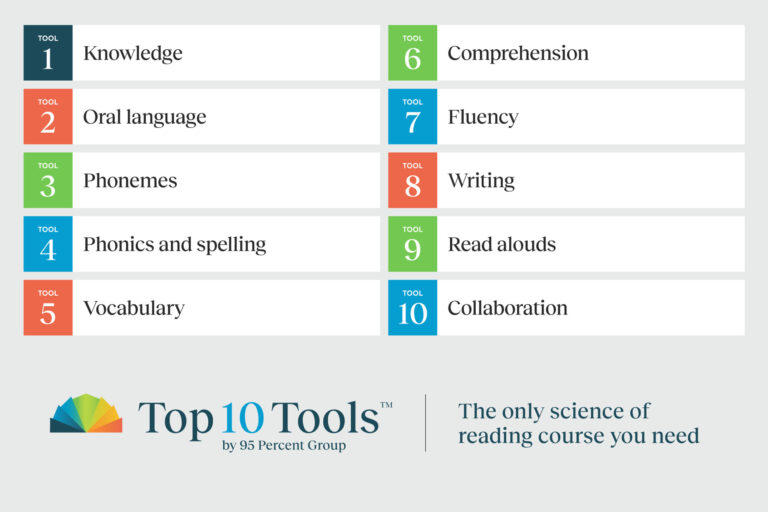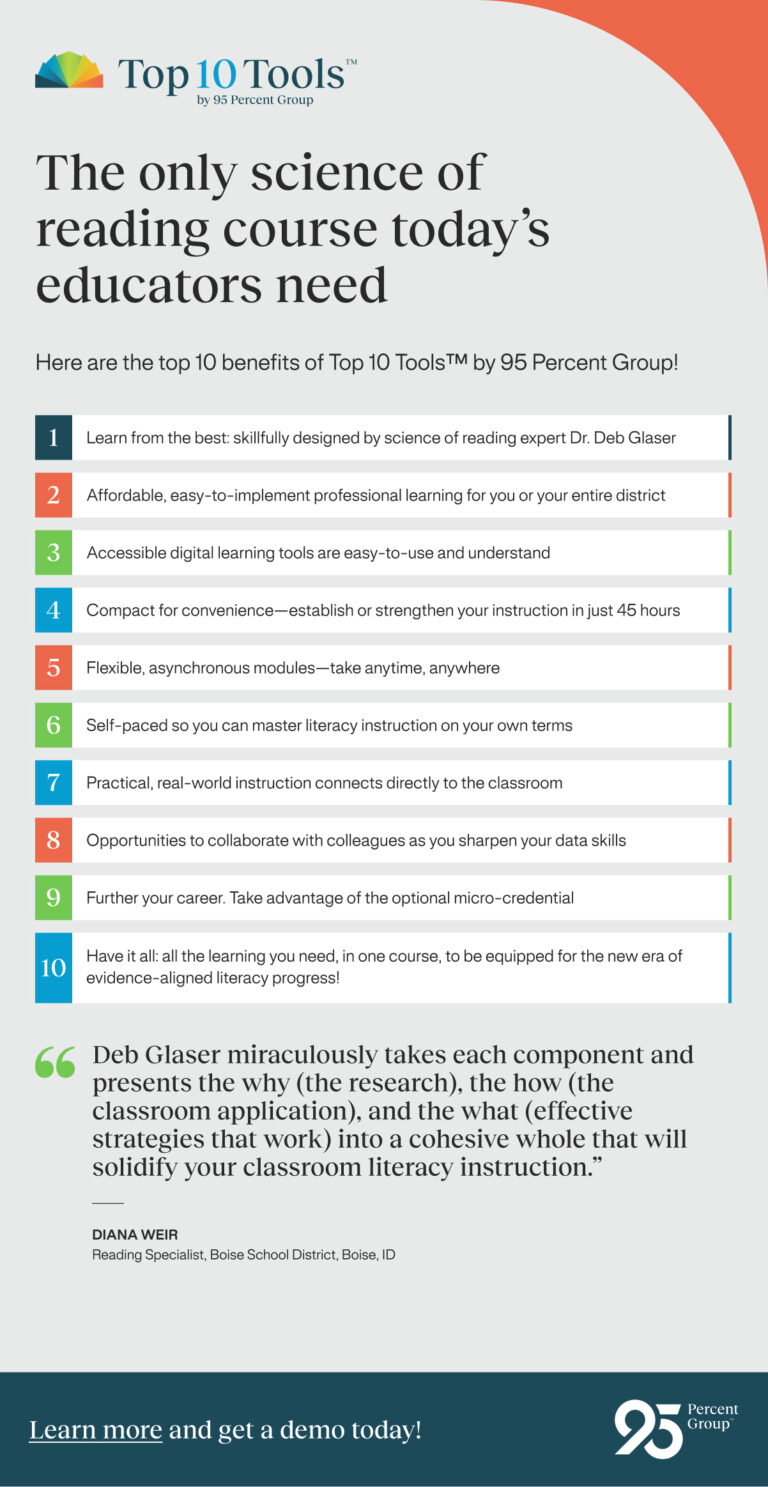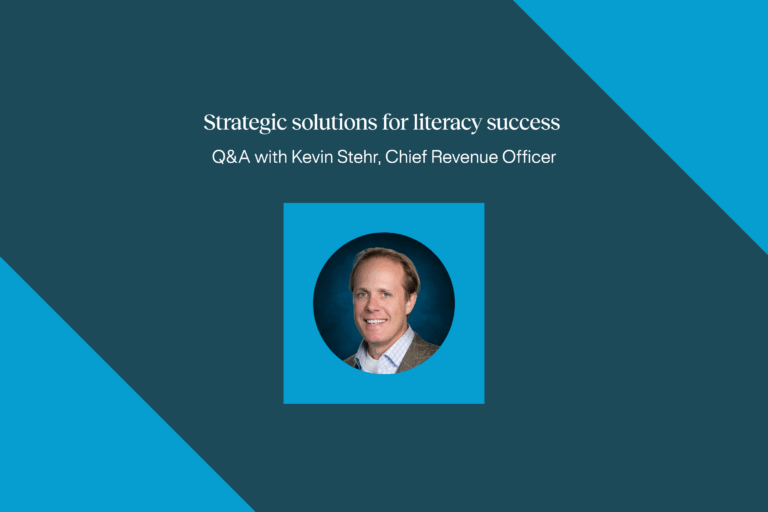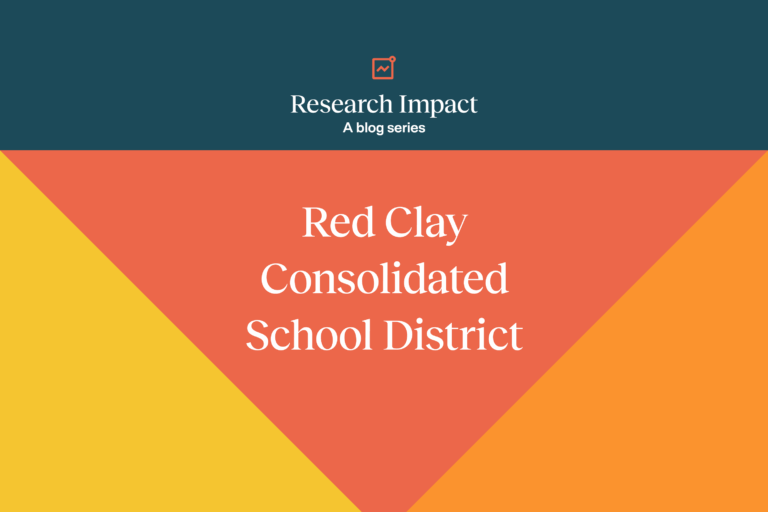Get to know the only science of reading course you need

The Top 10 Tools course was AMAZING. It was absolutely the best training I have ever received…It has helped me restructure grade-level interventions, develop connected lessons, actually use data rather than just gather it, and use many different ways to engage students. The absolute best part of the course is the impact it had on student learning. Scores are soaring as a result of the concepts, research, and practices presented throughout the course.
Mary Spiker
Kindergarten teacher and 2017 Idaho Teacher of the year Mary Spiker sums up how taking the Top 10 Tools by 95 Percent Group™ course has impacted her professional life and the lives of her students. Deborah Glaser, EdD designed this comprehensive course to boost teachers’, coaches’, and administrators’ understanding of the science of reading—for novices or for anyone needing a refresher—with the goal to improve instruction by putting structured literacy to work in the classroom.
We spoke with Dr. Glaser to learn more about her inspiration and motivation for creating Top 10 Tools, the structure of the course, and the outcomes she has observed for districts, schools, and teachers who have adopted it.
The only science of reading course educators need
Top 10 Tools is the preferred course for establishing or strengthening your knowledge of the science of reading. Here are the top 10 benefits of Top 10 Tools!
- Affordable, easy-to-implement professional learning for you, your department and school, or your entire district
- Accessible digital learning tools are easy-to-use and understand.
- Learn from the best: Skillfully designed by Dr. Deb Glaser, a leading expert in the science of reading!
- Compact for convenience—establish or strengthen your literacy instruction in just 45 hours
- Flexible, asynchronous modules—take anytime, anywhere
- Self-paced so you can master literacy instruction in your own learning style
- Practical, real-world instruction provides video modeling and practice opportunities that connect directly to the classroom.
- Allows for collaboration with colleagues to improve data skills and apply data insights to student instruction.
- Further your career. Take advantage of the optional micro-credential.
- Have it all: all the learning you need, in one course, to be equipped for the new era of evidence-aligned literacy progress!
Top 10 Tools is a compact and comprehensive suite of tools on the science of reading. Educators learn what to teach, how to teach it, and how to continue learning through ongoing collaboration with colleagues.
Why would a district adopt or an educator choose to take Top 10 tools?
Tools = Knowledge + Practice. Educators need tools, just like carpenters or mechanics. In our field we have to keep current with what the most recent findings are that are going to impact our instruction. So much has changed in our understanding of how the brain learns to read. States, districts, and schools across the country are implementing structured literacy instruction based on the science of reading. But most teachers, administrators, reading specialists, and curriculum directors are typically unprepared. The Top 10 Tools course helps everyone get up to speed quickly—in 45 hours of self paced, flexible, and accessible learning modules.
For people who have taken some of the other, more well-known, time-intensive trainings in the field, it deepens their understanding of the knowledge they’ve gained and connects it to classroom practices. There’s a conception out there that if educators participate in one high level training, they’ve got it. I hear that from teachers and from school leaders when they ask for Morpheme Magic training. They’ll say, ”We don’t need any of the background—my teachers have all had science of reading training. They know this.” They think they do, but in fact, if you ask them a basic question, they frequently don’t know how to answer.
Especially for a lot of teachers who are learning the science of reading for the first time right now, they report that hearing it again helped them understand that they really did not understand this content at as deep a level as they thought they did.
And the course can be taken in two different versions: for 3 PD Credits/CEUs or the more rigorous IDA accredited version. In addition, educators can earn a Top 10 Tools micro-credential to demonstrate they have achieved a high level of competency in structured literacy instruction.
We needed something that was relatively cost-effective, that was asynchronous, that would allow our teachers to do it in bite-sized pieces. We also like the videos and the research coupled with some takeaway tools that you could try out—so it checked all the boxes for us in terms of full scale implementation…I haven’t seen a professional development tool that can change teacher knowledge in such a profound way that’s asynchronous and affordable.
Casey Bertram
How is the course structured?
Teachers need models. So a strong design element in the training was to have classroom videos that would help teachers see what this teaching looked and sounded like in action.
I knew I wanted the course to be a narrative. I wanted teachers to feel like I’m talking to them. The information while complex is presented in a way that helps you understand and then helps you make connections to your teaching. The narrations speak to you, the teacher. Engaging graphics help keep your attention, with shorter narratives followed by review, synthesis, and application. The course is always guiding the teacher to synthesize and connect the information to their world.
Conceptual Models
I built the course around four conceptual models:
- The Simple View of Reading—developed by cognitive scientists Philip Gough and William Tunmer in 1986 and modified by Wesley Hoover and Philip Gough in 1990. The Simple View of Reading presents the complex reading process in a simplified way. It is the perfect model to begin the study of reading science because it lays the foundation for reading comprehension under two domains—word recognition and language comprehension.
- Scarborough’s Reading Rope—developed by Dr. Hollis Scarborough. This visual metaphor for skilled reading shows how the many “strands” of reading braid together to elements of language comprehension and word recognition. It reminds us of the many components of language that grow and evolve over time contributing to reading comprehension in increasingly strategic ways.
- The Four-Part Processing Model for Word Recognition—developed by Seidenberg and McClelland in 1989 and included in Marilyn Adams’ book Beginning to Read in 1990. The four-part processing model explains how the visual component of reading—letters and letter combinations—interact with the language centers of the brain to access meaning.
- Linnea Ehri’s phases of word recognition development—Ehri’s model shows how readers pass through four predictable phases in their acquisition of phoneme awareness and orthographic knowledge. Understanding these phases helps teachers know what to assess and how to plan appropriate instruction to help students pass through the phases, each building on the previous.
These four conceptual reading models are introduced and expanded upon in the course to provide a foundation from which reading acquisition and instruction are presented.
What are the 10 Tools?
As I began creating the course, I started writing on big post-its all around the room: this is the content that needs to be in it; this is what I need to cover because this course is going to be a comprehensive training for teachers. I realized that I could group everything into 10 categories, so the course features 10 modules, one for each tool.
First I’ll describe the tools and then, we’ll hear what a few educators who have taken the course have to say about why they chose to take it.
TOOL 1 – Knowledge—a reading teacher’s foremost tool
In the course I make very clear that you can take these modules in different orders, but you must start with the first one because it helps you understand that your very first and foremost tool is your knowledge.
It’s not only knowledge of what you need to teach but how to teach it. You will emerge from this course having a stronger appreciation for and deeper level knowledge for yourself of reading, how it happens, and the tools that you need for integrating this knowledge into your pedagogy within the classroom.
TOOL 2 – Oral language—a foundation for literacy
Then we move into the next tool which is language because language—your receptive and expressive language—is almost perfectly correlated with your ability to learn to read. So right from the very beginning and in everything we teach, we recognize that the classroom is a language petri dish. It is growing language all the time and our role as teachers is to advance our students’ language no matter where they are when they come to us. We have to advance their spoken and their receptive language because that is forming the basis for the words and the concepts, the syntax, the structure of the language that they will be reading.
TOOL 3: Phonemes—paving the way to print and meaning
Teachers learn the correct articulation of the consonant and vowel phonemes, and discover strategies to bring students’ attention to phonemes throughout the school day. This tool deepens an appreciation for the phoneme’s role in word meaning, reading, and spelling.
TOOL 4: Phonics and spelling—effective decoding and encoding instruction
This module presents the reading brain and the role of decoding in comprehension. Teachers explore Ehri’s phases of word recognition development, one of the 4 conceptual models underpinning Top 10 Tools, and learn to identify the four areas in the reading brain and understand reading activation patterns. Teachers will recognize students’ word recognition phases and learn to apply appropriate word level instruction in the classroom.
TOOL 5: Vocabulary—the blueprint of a word
This tool helps teachers study the design and structural aspects of words. It presents strategies for developing vocabulary lessons that teach words explicitly and helps teachers identify multiple opportunities throughout the school day to expand student vocabularies through implicit instruction. The module supports teachers in bringing deeper thinking about vocabulary to classroom instruction; as they grow their own richer understanding of words, their vocabulary lessons Increase their students’ curiosity about words and expands vocabulary.
TOOL 6: Comprehension—the text and the mental model
This tool builds an understanding of comprehension through studying and differentiating between the process and the product of reading comprehension, and how to consider these in their lesson planning. Teachers practice how to use a framework to plan comprehension lessons that will help them to better guide the development of students’ mental models before, during, and post reading.
TOOL 7: Fluency—understanding practice and automaticity
This tool helps teachers connect reading fluency to other reading and language skills so they can improve reading fluency through well planned practice activities. Teachers learn to identify, support, and assess the skills that contribute to fluent reading across the span of reading development.
Now let’s go into a little more depth on the last 3 tools.
TOOL 8: Writing—written responses to reading
Starting in kindergarten and moving on up through the grades, we need to be addressing the instruction of how to write—how to put ideas and thoughts onto paper to convey knowledge and share it with others. With the eighth tool, teachers build knowledge about both the underlying and higher-level language skills required to write. Providing daily writing opportunities in response to reading is a main focus in this module because writing is the perfect task that we can engage students in as a result of what they read. What I can put into words, I understand at a much deeper level which strengthens my comprehension.
The module helps teachers understand and incorporate purposeful instruction in note taking, sentence writing, and summary writing so they can provide effective, engaging instruction that helps students capture and formalize their thinking.
TOOL 9: Read Alouds—a tool for building language comprehension
Read Alouds is a tool for listening comprehension because that is such a big one—especially when children are younger. Aside from the pleasure of shared time together and our love of a good story, a lot of positive language development happens through the simple joy of reading a book out loud. This module explores research that outlines the significance of the read-aloud. It provides ideas for how to work this special time into the teacher’s busy, fully scheduled day and get the most out of it.
TOOL 10: Collaboration—two heads are better than one
Teaching as a community of educators is the best approach for our students. Teachers don’t have to do this work alone. Putting our heads and hearts together to plan responses to identified student needs, working to develop solutions and celebrating success together, is what our students deserve. This collaboration module addresses how we bring the new knowledge and practices together and sustain our learning through our school building-based professional learning communities. Of course, it doesn’t necessarily have to be building-based. It could be digital—with my group of colleagues that I meet in a video meeting regularly.
This tool provides support through collegiality, through collaborative efforts with others, to revisit the information that we have learned and connect it to our students by looking at data together and analyzing it. We take what we know, and the knowledge we have gained to apply the best treatment for students who are not making the gains that we have In mind for them.
How does tool 10 help educators grow their data skills to improve instruction?
The data component in tool 10 is based on what we call an outcomes driven model established by Roland Good and Ruth Kaminsky, the original authors of DIBELS. The process begins in a collaborative meeting with looking at Benchmark data, typically from the three big Benchmark assessments per year. Sometimes it’s just two. With Benchmark you have a valid and reliable assessment that helps differentiate the children and helps you identify the kids who are at risk.
Once you identify the kids at risk, you go to the next step, which is now digging deeper and applying a diagnostic process to help determine those areas that are impeding that student’s ability to progress. Next is designing the intervention or the instruction for that student and others who have that same diagnostic need. That’s where the assistance from the collaborative effort takes place—getting this help from your colleagues.
“Remember in the training we learned that? Have you tried this activity? Have you spent more time in this element of your lesson?”
Those are the kinds of conversations we want to see happen in those collaborative meetings.
And then once the plan is made, you put the plan in place. An important part of that plan includes progress monitoring. You identify who is going to give the progress monitoring assessment, how often, and how you’ll review that assessment so that you can see if your instruction is working. Then you meet back again—maybe you meet once a month—to look at data and review.
“Are they making the gains they want to see made? Do we need to tweak something in our instruction?” Then you go through that cyclical model: plan the instruction, provide it, progress monitor, assess whether it’s working or not. Make changes or continue. And you go in the cycle.
That’s the process upon which tool 10 is built. The professional learning community becomes part of your professional learning. We continue learning. There’s no end. In fact, that would be one of the top 10 reasons that we would take a class like this. It’s because there is no end to what we can learn as professional reading teachers.
What motivated you to develop Top 10 Tools?
I was in the first group of eight people that trained LETRS and I worked with the development of the first and second editions of LETRS. I created the Top 10 Tools course because I noticed that the teachers were receiving a lot of knowledge about the science of reading but very little connection to the classroom.
We all know that the easiest avenue to fall back into is what we’re familiar with. I would wonder: Were they able to take this back into their classroom? Did they really understand how to activate their new knowledge about how children learn to read in their instruction in the classroom? Did they have the tools they needed? Did they have the materials? Did they have the ability to understand what it means to teach explicitly and systematically? Did they have the necessary elements and components that children need in order to read and learn to read?
I had teachers reaching out to me all the time, asking “Do you have any recordings of yourself teaching that I could watch? I need to go back in there and see it again, and see how you model teaching in the training.”
So I decided that’s what I would build this training around: here’s the knowledge you need, and then this is what it looks like when you apply it in your classrooms.
Let’s revisit some of the benefits.
I really appreciate Leo Buscaglia’s insight, “Change is the end result of all true learning.” So I asked teachers, “What changes have happened in your instruction? And what have you learned by applying those changes?” Here are a few of the many responses I’ve received:
Total game changer. I find myself applying so much more than I expected this year. Really impacts your students. Builds background, shows the research and gives educators practical ways to start using right away. Love it!
David Pelc
This class was amazing. It was encouraging to me in reminding me that what I was doing with my kindergarten was the right thing to do, even if others weren’t doing it. And it gave me so, so, so many new things to try this next year. I appreciate all the extra articles that were linked and have printed and read almost all of them so far. What an amazing class. Almost a year after finishing the course, I am still using things I learned from the class every single day! I talk about it often and have recommended the class to as many people as I can. Thank you for all you do!
Erika Gordon
Ready to learn more?
Don’t miss the other posts in this 3-part series.
Following our conversation with Dr. Glaser, we interviewed two educators in depth to hear about their experiences doing the Top 10 Tools course, and implementing it district wide. Read Part 2 to hear in depth from Casey Bertram, Superintendent of Bozeman Public Schools. In Part 3, instructional coach and student performance strategist for Fargo Public Schools in North Dakota discusses how the Top 10 Tools course helped them build a foundation for the science of reading.
To learn more and view a demo of Top 10 Tools by 95 Percent Group™, click here.




